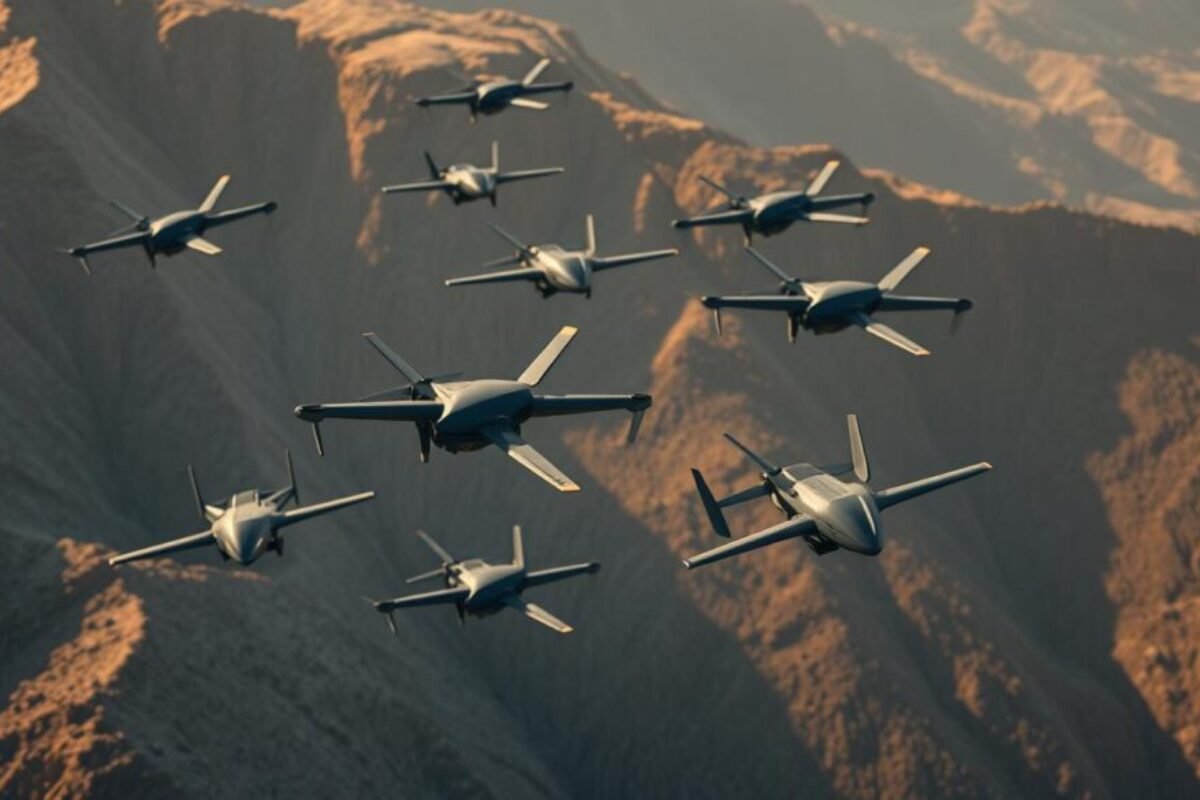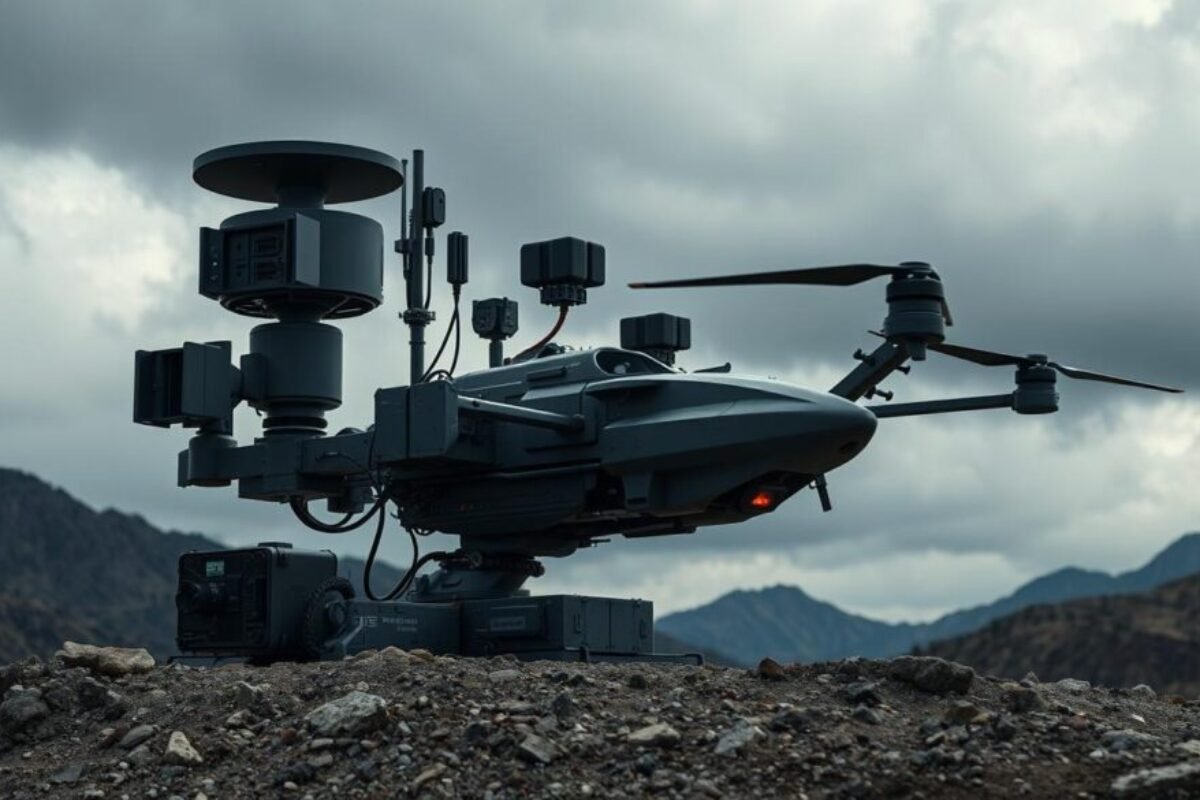Drone Swarms: Coordinated Autonomy in the Age of AI-Driven Warfare
Imagine a sky filled with hundreds of drones, all moving together. This is not just science fiction. Over 50 countries are working on drone swarms, which are groups of drones that work together. They are changing how we think about war.
These drone swarms are a big change from using manned aircraft. They are making the sky a new battleground. They are changing how we plan and fight wars.
Drone swarms are not just more eyes in the sky. They are teams that can work together and make quick decisions. This is a big change in how we fight.
Drone swarms are making warfare more efficient and innovative. They are changing how we think about power and control. It’s important for everyone to understand their impact.
Key Takeaways
- Drone swarms represent a significant leap in AI-driven warfare, enabling unprecedented aerial coordination.
- The proliferation of autonomous drones signifies a shift from traditional human-piloted operations to AI-driven systems.
- Swarm intelligence in UAVs is shaping up as a cornerstone of modern military strategy.
- Defense mechanisms and offensive tactics alike are evolving through the integration of drone swarms.
- Nations are investing heavily in the development of autonomous drone technologies to gain strategic advantage.
- Drone swarms exemplify the synergy of technology and tactic, reinventing warfare dynamics.
The Dawn of AI-Driven Warfare: An Overview
The way we fight has changed a lot. We’ve moved from old combat ways to using AI in warfare. This change is not just about new tech. It’s about changing how we defend ourselves around the world.
By using AI in our military plans, we’ve started using more machines. These machines, like drones, are key in today’s military strategies.
Understanding AI’s role in war is important. Drones have changed from just watching to doing complex tasks on their own. They use AI to make decisions fast, without needing a human.
Transitioning from Traditional Combat to AI Operations
AI has changed how we fight. Decisions used to be made far from the action. Now, AI can make decisions fast, based on real-time data.
This makes our military faster and more accurate. It helps us hit our targets better, with less harm to others.
The Strategic Shift to Autonomous Drone Systems
Using drones on their own is a big step in war tactics. These drones are not just tools. They are key to our military plans today.
Thanks to advanced drones, we can do complex missions. These missions can change plans as needed, without needing a human. This makes our military more efficient and safer.
The Architectural Genius Behind Drone Swarms
Drone swarms are not just new; they are a game-changer in combat and reconnaissance. They use advanced AI and learn from nature, like birds and insects. This makes them incredibly efficient and adaptable.
Inspiration from Nature: Flocks, Schools, and Colonies
Drone swarms fly like birds, working together as one unit. They can cover large areas with precision and safety. This is great for watching over places and for tactical missions.
Their design also includes complex decision-making, inspired by insects and animal groups. This shows how they can work together effectively.
Integrating AI for Swarm Intelligence
AI helps drones talk to each other in real-time. This makes them truly intelligent as a swarm. They can change their actions based on what’s happening around them and what they need to do.

Drone swarms mix nature and technology in a powerful way. They make drones better and more effective together. This is a big step in aerial robotics and autonomous systems.
Defining Swarm Intelligence in Aerial Robotics
In aerial robotics, swarm intelligence is a big step towards making systems work on their own. It changes how drones work together and makes them more agile. This is a big deal for how we use drones today.
At the core of swarm intelligence in drones is decentralization. This means each drone acts on its own, without needing someone to tell it what to do. This freedom is key for drones to work together in complex ways.
From Decentralization to Emergence
Swarm intelligence in drones is all about how they work together. It’s about using local information to make smart decisions quickly. This is important for drones to work well together in real-time.
Principles Guiding Swarm Behavior
There are a few key ideas that make swarm intelligence drones work. These are stigmergy, adaptability, and robustness. These ideas help drones talk to each other and adapt to challenges. This makes drone teams more effective.
| Principle | Description | Impact on Swarm Intelligence |
|---|---|---|
| Stigmergy | A mechanism of indirect coordination through the environment. | Enhances real-time coordination without central command. |
| Adaptability | Ability to adjust operations based on changing external conditions. | Ensures efficient response to dynamic operational scenarios. |
| Robustness | Maintaining operational capabilities despite disturbances. | Guarantees reliability and endurance in complex environments. |
Swarm intelligence drones show a big leap in aerial robotics. They are not just about drones working together. They are the start of a new era in how drones will move and work on their own.
Technological Milestones in Drone Swarm Coordination
As we explore advanced aerial warfare, drone swarm coordination is key. These achievements have boosted autonomous drone systems and changed military strategies. Now, UAV swarming tactics are a big part of global military plans.

AI has made drone control more efficient and effective. This change marks a big shift in aerial warfare technology. We see a move from old tactics to new, smart, and autonomous operations. These use group intelligence to tackle complex tasks without human help.
Breakthroughs in Autonomous Drone Systems
The growth of autonomous drone systems is impressive. AI has made drones smarter, allowing them to process data and make decisions quickly. This is key for fast, coordinated attacks that can change plans on the fly.
Global Realignment Towards UAV Swarming Tactics
There’s a big move towards UAV swarming tactics worldwide. Countries are quickly improving their drone skills to use swarming’s strategic benefits. These tactics, inspired by nature, make drone swarms a strong force in today’s wars.
These advancements will keep changing military battles. They show how important innovation is in shaping future aerial warfare.
Global Leaders in Swarm Drone Technology
The world is seeing big steps in drone swarm tech, thanks to the United States military and China. Europe is also making great strides in UAV innovation. These areas are key in shaping the future of drones with their advanced tech and smart uses.
In the United States, projects like Project Replicator and Perdix Swarm are leading the way. They focus on making drones work together better and smarter. These efforts make the US military a leader in drone tech. China is also making big moves, with drones like the Jiu Tian Mothership showing great skill in working together.
Looking at Europe, there’s a lot of excitement in UAV innovation. Countries like Germany, the UK, and Sweden are exploring new ways for drones to work together. They’re working on better communication systems and AI to make drone swarms more effective.
Together, the US, China, and Europe are changing how we think about using drones in the military. They’re setting a new standard for the future of drone warfare.
Applications of Drone Swarms in Modern Warfare
Drone swarms are changing how we fight in modern warfare. They bring new ways to gather information and defend against enemies. These swarms can do things we never thought possible before.
Drone swarms can cover a lot of ground fast. This makes them key for getting intel and watching over big areas. They help in making smart decisions and plans in dangerous places.
Drone swarms also change how we attack and defend. They can work together to launch attacks that traditional defenses can’t handle. This gives us an edge in battles.
| Function | Benefits | Application in Warfare |
|---|---|---|
| Reconnaissance | Extended surveillance, high coverage speed | Continuous monitoring, target identification |
| Defense | Fast response, adaptive formations | Protecting critical assets, intercepting threats |
| Attack | Saturation tactics, coordinated strikes | Disabling enemy defenses, multi-target engagements |
Drone swarms also boost our defense systems in big ways. They can create shields that change to meet threats. This helps keep important things safe in war zones.

Artificial Intelligence: The Brain of Drone Swarms
In the world of aerial warfare, artificial intelligence is more than just a helper. It’s the brain of drone swarms. These systems use AI to make fast, accurate decisions that humans can’t match.
Thanks to machine learning, these drones get smarter with each mission. They can do complex tasks and change plans quickly. This mix of set plans and quick changes makes them very effective on the battlefield.
These drones have been tested in real missions. They show how AI can make smart decisions on its own. With each mission, they get better at their job.
One key feature is how drones work together. They share data and tasks like a single unit. This makes them very good at complex operations. Each drone helps and learns from the others, making them a strong team.
The future of war looks different with these advanced drones. They change how we fight, using AI to make quick, smart decisions. As these drones get better, they will change warfare even more, starting a new era in defense technology.
Challenges and Ethical Considerations of Autonomous Warfare
Autonomous warfare brings up many ethical, legal, and operational challenges. It changes how we think about military battles. As AI systems are used more in combat, there’s a big debate about their use. This debate makes military leaders and lawmakers think hard about moving forward while staying ethical.
Using autonomous weapons fast raises questions about making life-or-death choices with algorithms. These issues are part of a bigger talk about AI in war. It makes us question the very nature of war and its rules.
The ability for AI systems to perform combat tasks independently without direct human oversight challenges traditional conceptions of warfare and raises pressing ethical considerations.
We’re at a key moment in military tech. It could shape future war rules and ethics for years. Making rules for autonomous warfare is not just needed, it’s a moral must.
The Debate over Autonomous Weapons Systems
The debate on autonomous weapons focuses on their ethics in war. People argue about whether AI systems should make decisions on their own. Some say they’re efficient and safe, while others worry about their moral and ethical sides.
Legal and Moral Implications of AI in Combat
Talking about AI in war goes beyond laws in one country. It touches on international law too. Laws and agreements that have guided war are changing with AI. We need a global agreement to make sure AI helps keep us safe without losing our values.

In conclusion, as we keep making and using AI in war, the stakes get higher. We must create rules that mix ethics, tech, and respect for war laws.
| Key Concern | Ethical Challenge | Legal Implication |
|---|---|---|
| Decision-making Autonomy | Moral justification for AI decisions in combat | Alignment with international humanitarian law |
| Increased Weaponization | Responsibility for AI-induced collateral damage | Regulation of autonomous combat technology |
| Technological Reliability | Dependence on potentially flawed AI systems | Establishing accountability for system failures |
Case Studies: Real-World Implementation of Drone Swarms
In this section, we explore drone swarm case studies that show their big role in today’s wars. We look at how drones are used in different parts of the world. This helps us see how they help in defensive drone applications and offensive swarm tactics.
Assessment of UAV Efficiency in Conflict Zones
Drone swarms are very useful in war zones. They help commanders get important information quickly. This makes it easier for them to make good decisions.
Drone swarms are used in both defense and offense. They watch borders to warn of threats. They also attack enemies in a coordinated way. This makes them very useful in war.
Drone swarms have changed how we fight, making things like watching and attacking better. As they get better, they will be used in even more ways. This shows how important they are for the future of war.
Advances in Edge Computing for Real-Time Strategy
Drone technology has grown a lot thanks to edge computing. This has made real-time drone strategy much better. Drones can now make quick decisions because they have powerful computers right on them.
This means they can work together better and make smarter choices. This is very important for the military and other fields that need fast and accurate data.
Edge AI helps drones work together more smoothly. This makes them more effective in complex situations. It’s changing how drones operate, making them more independent and cooperative.
Edge computing and swarm intelligence have opened a new chapter in drone strategy. Drones with edge AI are changing warfare. They are faster and more precise than old systems.
As we keep improving these technologies, drones will do even more amazing things. They will change many industries with their fast and smart actions.
Future of Warfare: Autonomous Drones and Beyond
The future of warfare is changing fast with autonomous drones leading the way. They’re moving from just scouting to being full autonomous strike forces. This change comes from big steps in next-generation warfare technology. It’s making UAV systems work better together for today’s battles.
UAV swarming tactics are a big part of this change. It’s like how animals work together in nature. Many drones work together to outsmart enemies with speed and accuracy. This is different from old ways of using one drone at a time.
From Reconnaissance to Autonomous Strike Forces
Autonomous drones are now key in battles, not just for looking around. They’re part of the attack plans. These drones can make decisions on their own, thanks to smart algorithms and learning.
Projecting the Next Generation of UAV Swarming Tactics
Drone tech is getting better, and swarming tactics will soon be the norm. This means drones will work together better than ever. They’ll be able to do missions faster and more efficiently. This will change how the military works in many ways.
In the end, autonomous systems will play a huge role in future wars. They will make decisions without needing humans. This marks a big change towards a future where machines lead the way.
The Role of International Regulation in Autonomous Warfare
The rise of autonomous warfare has made international rules more important. As countries invest more in these technologies, making clear drone swarm rules is key. These rules are vital for safety and keeping peace worldwide.
Efforts to Establish Guidelines for Drone Swarms
Drone technology is growing fast in military use. So, there’s a big effort to make strong drone swarm rules. These rules help keep drone use in line with global standards of war, stopping misuse and conflict escalations.
Global Consensus on Limitations and Boundaries
Finding common ground on war limits is essential. This agreement sets rules for all to follow with autonomous tech in war. The goal is to stop conflicts from getting worse and keep use of these systems ethical and lawful.
Drone Swarms
We’ve reached a milestone with drone swarms in military strategies. These systems use the highest level of coordinated autonomy. This has changed the game on the battlefield.
Drone swarms have brought a new way to fight. They make military actions smarter, faster, and more effective. Their collective intelligence allows for quick decisions, beating traditional warfare.
Drone swarms do more than fight. They also do better surveillance and targeting. This makes operations safer for humans. As we keep improving these techs, we’re entering a new era of military power.
| Feature | Benefits | Operational Impact |
|---|---|---|
| Real-Time Data Processing | Enhanced decision-making speed | Quicker tactical responses |
| Collective Intelligence | Adaptability in dynamic environments | Higher success rate in missions |
| Autonomous Coordination | Reduced human error | Increased mission safety and efficiency |
Drone warfare has reached new heights. It shows the top of modern military tech. It’s changing how countries defend themselves, making it more efficient and precise.
Conclusion
AI-driven autonomy is changing modern warfare a lot. Drone swarms are making a big impact. They are already changing how countries fight and prepare for battles.
Drone swarms are making military forces better with affordable, adaptable, and unmanned systems. They are becoming key in modern warfare tactics.
Warfare is changing fast, thanks to drone swarms. We need to talk about the ethics, laws, and strategies of using this technology. It’s important to work together globally to handle these issues.
This way, we can make sure these powerful tools are used right. They should help keep the world safe and stable.
Drone swarms are a big deal in warfare, marking a major change. This change has started and will keep growing. We all need to figure out how to use this new tech wisely.
We must make sure AI-driven autonomy is used for the good of all. We should aim for a future where innovation and ethics go together.





